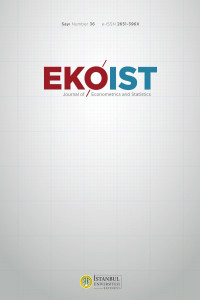PEGSÜ Ülkelerinin Dış Ticaret Rekabet Gücü AB14 Ülkelerine Yakınsıyor mu? Ani ve Yumuşak Değişimli Fourier Panel Birim Kök Testinden Kanıtlar
Öz
Bu çalışmada pazar ekonomisine geçiş sürecinde olan 13 ülkenin (PEGSÜ; Arnavutluk, Bulgaristan, Çek Cumhuriyeti, Estonya, Hırvatistan, Letonya, Litvanya, Macaristan, Makedonya, Polonya, Romanya, Slovenya ve Slovakya) dış ticaret rekabet güçlerinin, Avrupa Birliğinin 14 temel üyesinin (AB14) dış ticaret rekabet gücüne yakınsaması, 1993:M01- 2021:M08 dönemi için, Bahmani-Oskooee vd. (2014) tarafından geliştirilen ani ve yumuşak değişimli Fourier panel birim kök testiyle analiz edilmiştir. PEGSÜ ülkeleri arasında yatay kesit bağımlılığının varlığı Breusch ve Pagan (1980) LM, Pesaran (2004) LMS ve Baltagi vd. (2012) LMBC testleriyle incelenmiş ve bu ülkeler arasında yatay kesit bağımlılığının varlığı görülmüştür. Yatay kesit bağımlılığını göz önünde tutarak çalışan Bahmani-Oskooee vd. (2014) panel birim kök testinin bireysel sonuçlarına göre; Hırvatistan haricindeki ülkelerin, dış ticaret rekabet gücü noktasında AB14 ülkelerine yakınsadıkları görülmüştür. Panelin geneline ilişkin yapılan analizlerde, serilerdeki ani ve yumuşak yapısal değişimlerin varlığı göz önünde bulundurulduğunda, panele dahil edilen 13 PEGSÜ ülkesinin, dış ticaret rekabet gücü yönünden, AB14 ülkelerine yakınsamakta oldukları görülmüştür. Test yönteminin bu ülkelerdeki ani ve yumuşak yapısal değişimleri başarılı bir şekilde tespit ettiği görülmüştür. Elde edilen bulgular; AB’ye sonradan katılan ve AB adayı olan PEGSÜ ülkelerinin AB mevzuatlarına uyum sürecini başarıyla yürüttüklerini, AB’nin de bu ülkelere yaptığı finansal ve teknik desteklerle ülkelerin dış ticaret rekabet güçlerini artırdığını göstermektedir.
Anahtar Kelimeler
Pazar Ekonomisine Geçiş Sürecindeki Ülkeler Dış Ticaret Rekabet Gücü Ani ve Yumuşak Değişimli Fourier Panel Birim Kök Test
Kaynakça
- Referans1 Baltagi, B. H, Feng, Q. and Kao C. (2012). A Lagrange Multiplier test for Cross-sectional Dependence in a Fixed Effects Panel Data Model. Journal of the Econometrics, 170, 164–177, 2012.
- Referans2 Bahmani-Oskooee, M., Chang, T. and Wu, T. (2014). Revisiting Purchasing Power Parity in African Countries: Panel Stationary Test with Sharp and Smooth Breaks. Applied Financial Economics, 24(22), 1429-1438.
- Referans3 Becker, R., Enders, W. AND Lee, J. (2006). A Stationarity Test in the Presence of an Unknown Number of Smooth Breaks. Journal of Time Series Analysis, 27(3), 381-409.
- Referans4 Breusch, T. S. and Pagan, A.R. (1980). The Lagrange Multiplier Test and Its Applications to Model Specification Tests in Econometrics. Review of Economic Studies, 47: 239-53.
- Referans5 Carrion-i Silvestre, J.L., Barrio-Castro, T.D. and Lopez-Bazo, E. (2005). Breaking the Panels: An Application to the GDP Per Capita. Econometrics Journal, 8(2), 159- 175.
- Referans6 Chinn, M. (2006). A Primer on Real Effective Exchange Rates:Determinants, Overvaluation, Trade Flows and Competitive Devaluation. Open Economies Review, 17, 115–143.
- Refrans7 Darvas, Z. (2021). Timely Measurement of Real Effective Exchange Rates. Bruegel Working Paper, No. 15/2021.
Does the Foreign Trade-Driven Competitive Power of Transition Economies Converge Toward that of EU14 Countries? Evidence from Fourier Panel Unit Root Test with Sharp and Smooth Breaks
Öz
This study analyzed whether the foreign trade-driven competitive power of the 13 transition economies (i.e., Albania, Bulgaria, Czech Republic, Estonia, Croatia, Latvia, Lithuania, Hungary, Macedonia, Poland, Romania, Slovenia, and Slovakia) converges toward that of the 14 main European Union countries (EU14) for the period of 1993:M01–2021:M08. The study used the Fourier panel unit root test with sharp and smooth breaks developed by Bahmani-Oskooee et al. (2014). The presence of a cross-sectional dependence among transition economies was examined using tests developed by Breusch and Pagan (1980) LM, Pesaran (2004) LMS, and Baltagi et al. (2012) LMBC. A cross-sectional dependence was observed among these countries. According to individual results obtained from the panel unit root test developed by Bahmani-Oskooee et al. (2014), by considering cross-sectional dependence, all countries except for Croatia were found to be in a closer position to EU14 countries in terms of foreign trade-driven competitive power. Considering the presence of sharp and smooth structural breaks in series, the analyses on the overall panel revealed that the 13 transition economies, which are included in the panel, converge toward EU14 countries in terms of foreign trade-driven competitive power. The testing method was able to successfully determine the sharp and smooth structural breaks in these countries. Moreover, the findings show that transition economies that joined the EU at a later stage or are candidates for the EU have been successfully carrying out the EU harmonization process. From another aspect, the EU is increasing their foreign trade-driven competitive power by providing them with financial and technical support.
Anahtar Kelimeler
Transition Economies Foreign Trade-Driven Competitive Power Fourier Panel Unit Root Test With Sharp and Smooth Breaks JEL Classification
Kaynakça
- Referans1 Baltagi, B. H, Feng, Q. and Kao C. (2012). A Lagrange Multiplier test for Cross-sectional Dependence in a Fixed Effects Panel Data Model. Journal of the Econometrics, 170, 164–177, 2012.
- Referans2 Bahmani-Oskooee, M., Chang, T. and Wu, T. (2014). Revisiting Purchasing Power Parity in African Countries: Panel Stationary Test with Sharp and Smooth Breaks. Applied Financial Economics, 24(22), 1429-1438.
- Referans3 Becker, R., Enders, W. AND Lee, J. (2006). A Stationarity Test in the Presence of an Unknown Number of Smooth Breaks. Journal of Time Series Analysis, 27(3), 381-409.
- Referans4 Breusch, T. S. and Pagan, A.R. (1980). The Lagrange Multiplier Test and Its Applications to Model Specification Tests in Econometrics. Review of Economic Studies, 47: 239-53.
- Referans5 Carrion-i Silvestre, J.L., Barrio-Castro, T.D. and Lopez-Bazo, E. (2005). Breaking the Panels: An Application to the GDP Per Capita. Econometrics Journal, 8(2), 159- 175.
- Referans6 Chinn, M. (2006). A Primer on Real Effective Exchange Rates:Determinants, Overvaluation, Trade Flows and Competitive Devaluation. Open Economies Review, 17, 115–143.
- Refrans7 Darvas, Z. (2021). Timely Measurement of Real Effective Exchange Rates. Bruegel Working Paper, No. 15/2021.
Ayrıntılar
| Birincil Dil | Türkçe |
|---|---|
| Bölüm | Makaleler |
| Yazarlar | |
| Yayımlanma Tarihi | 29 Haziran 2022 |
| Gönderilme Tarihi | 29 Ocak 2022 |
| Yayımlandığı Sayı | Yıl 2022 Sayı: 36 |


